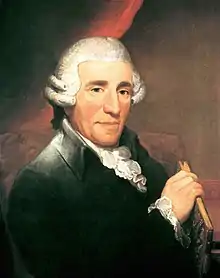Symphony No. 33 (Haydn)
The Symphony No. 33 in C major (Hoboken I/33) is a festive symphony by Joseph Haydn.[1] The precise date of composition is unknown. Haydn scholar H.C. Robbins Landon has dated this work to 1763–65.[2] It has also been suggested that it was written in 1760 or 1761, along with Symphony no. 32.[3]

Movements
The symphony is scored for two oboes, bassoon, two horns, two trumpets, timpani, strings and continuo.[4] Although Haydn's original timpani part has been lost, Robbins Landon has reconstructed it.[5] There are four movements:
The symphony is unusual for its independent viola writing in the opening movement and its sparse harmonies in the second. This latter feature may have been to allow Haydn, who typically conducted his works from the keyboard, to improvise freely.[6]
References
- Antony Hodgson, The Music of Joseph Haydn: The Symphonies. London: The Tantivy Press (1976): 59. It is placed in the chapter "The Early Festive Symphonies
- H. C. Robbins Landon, The Symphonies of Joseph Haydn. London: Universal Edition & Rockliff (1955): 663.
- (Hodgson, 1976): 58. "Symphonies Nos. 32 and 33 were written at much the same time."
- (Landon, 1955): 663. "2 ob., 2 cor. (C, prob. alto) and / or 2 clarini (trpt.), timp., str. [ fag., cemb. ]. The timp. pt. has not been discovered."
- (Landon, 1955): 787
- (Hodgson, 1976): 59